|
|
|
|
|
Map of JAPAN |
Map of Japan |
|
Find more Free Maps at our Maps and Geography Page
Find more Free Maps at our Maps and Geography Page
|
|
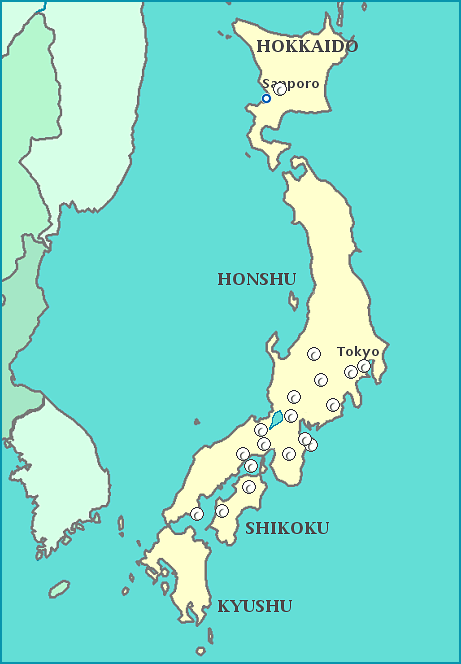
More Maps of Asia |
|
| Return to Top | |
Shikoku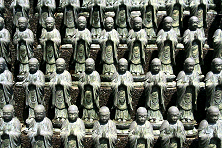 The island of Shikoku, the smallest of the main islands of Japan, is still
largely rural. It is on this island that one of the most important—and most
arduous—Buddhist pilgrimages takes place. Carrying a stick inscribed “Two
Traveling Together” - the pilgrim and the spirit of Kukai (also known as
Kobe Daishi) - white-clad pilgrims walk the 960 mile circuit of 88 temples,
over a beautiful but rugged trail of mountains, valleys and coastline. Nowadays
most pilgrims actually travel by bus or car, but a few still walk the entire
distance.
The island of Shikoku, the smallest of the main islands of Japan, is still
largely rural. It is on this island that one of the most important—and most
arduous—Buddhist pilgrimages takes place. Carrying a stick inscribed “Two
Traveling Together” - the pilgrim and the spirit of Kukai (also known as
Kobe Daishi) - white-clad pilgrims walk the 960 mile circuit of 88 temples,
over a beautiful but rugged trail of mountains, valleys and coastline. Nowadays
most pilgrims actually travel by bus or car, but a few still walk the entire
distance.
|
|
Miyajima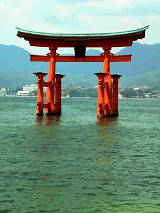 Miyajima is known as “shrine island”— No one who was close to dying or heavily
pregnant was allowed on Miyajima, for fear they might die on the sacred
island. Most famous is the red torii (gate), at the Itsuku Shrine, which
stands in the sea. The torii represents the entrance to the sacred.
Miyajima is known as “shrine island”— No one who was close to dying or heavily
pregnant was allowed on Miyajima, for fear they might die on the sacred
island. Most famous is the red torii (gate), at the Itsuku Shrine, which
stands in the sea. The torii represents the entrance to the sacred.
|
|
Sanuki-udon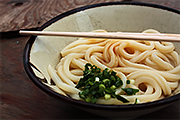 Sanuki-udon, (noodles) are said to be the best noodles in Japan.
Sanuki-udon, (noodles) are said to be the best noodles in Japan.
|
|
Himeji Castle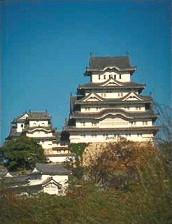 Himeji Castle is also “Castle of the White Heron” for the magnificent and
graceful way it rises from its hill toward the sky. It is one of the few
remaining Japanese medieval castles. The castle and its courtyards were
deliberately built to be maze-like, making it easy for tourists, as well
as potential attackers, to get lost.
Himeji Castle is also “Castle of the White Heron” for the magnificent and
graceful way it rises from its hill toward the sky. It is one of the few
remaining Japanese medieval castles. The castle and its courtyards were
deliberately built to be maze-like, making it easy for tourists, as well
as potential attackers, to get lost.
It is difficult to give an exact date for its construction, since it was built on the site of previous forts and smaller castles, incorporating pieces of them. The castle as seen today was built around 1609. |
|
Gifu - Cormorant Fishing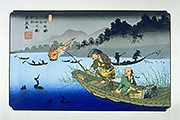 At night, trained cormorants dive for fish which are attracted to the light
of a small fire in a lantern on the front of the boat. Each bird has a ring
around its neck to keep it from swallowing the fish it catches. Cormorant
fishing has been done this way for 1300 years.
At night, trained cormorants dive for fish which are attracted to the light
of a small fire in a lantern on the front of the boat. Each bird has a ring
around its neck to keep it from swallowing the fish it catches. Cormorant
fishing has been done this way for 1300 years.
The cormorants are said to live as pets in the households of the fishermen. They are fed some of the fish they catch. Certainly the trained birds are highly valuable and well-treated. |
|
Nara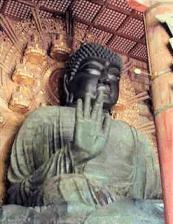 Nara is the old capital of Japan, preceding Kyoto. It has the Daibutsu,
the largest statue of Buddha in Japan, and the largest wooden building in
the world. Built as a response to a series of disasters and epidemics, the
statue was cast out of bronze, in eight castings for the various parts.
The “eye--opening” ceremony, which signified the essence of the Buddha being
in the statue, occurred in 752. The god Kasuga Taisha was said to ride a
deer onto the temple grounds. It is said that some of the deer have learned
to bow for food, in return for the visitor’s bow to them. Vendors sell crackers
to feed the deer, some of whom are extremely eager to be fed. There is a
hole in the bottom of one of the columns of the temple; it is said that
squeezing through the hole promises enlightenment.
Nara is the old capital of Japan, preceding Kyoto. It has the Daibutsu,
the largest statue of Buddha in Japan, and the largest wooden building in
the world. Built as a response to a series of disasters and epidemics, the
statue was cast out of bronze, in eight castings for the various parts.
The “eye--opening” ceremony, which signified the essence of the Buddha being
in the statue, occurred in 752. The god Kasuga Taisha was said to ride a
deer onto the temple grounds. It is said that some of the deer have learned
to bow for food, in return for the visitor’s bow to them. Vendors sell crackers
to feed the deer, some of whom are extremely eager to be fed. There is a
hole in the bottom of one of the columns of the temple; it is said that
squeezing through the hole promises enlightenment.
|
|
Mikimoto Pearl Island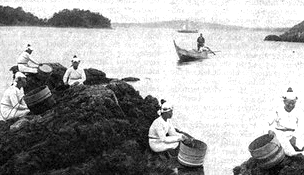 Mikimoto Pearl Island is ,located in the Bay of Toba. Mikimoto, in 1893,
was the first person to discover how to grow cultured pearls. It took several
more years, however, to obtain spherical pearls which were indistinguishable
from natural pearls. Suddenly these beautiful gems were much more affordable
to a wide range of women. Before the advent of cultured pearls, women pearl
divers would dive into the cold sea in search of oysters containing pearls.
It was hard and dangerous work, passed on from mother to daughter. Mikimoto
Pearl Island is a museum with shops showing pearls, pearl history, and pearl
jewelry both antique and contemporary.
Mikimoto Pearl Island is ,located in the Bay of Toba. Mikimoto, in 1893,
was the first person to discover how to grow cultured pearls. It took several
more years, however, to obtain spherical pearls which were indistinguishable
from natural pearls. Suddenly these beautiful gems were much more affordable
to a wide range of women. Before the advent of cultured pearls, women pearl
divers would dive into the cold sea in search of oysters containing pearls.
It was hard and dangerous work, passed on from mother to daughter. Mikimoto
Pearl Island is a museum with shops showing pearls, pearl history, and pearl
jewelry both antique and contemporary.
|
Return to Top |
Snow Festival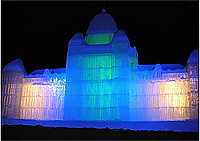 The Snow Festival is held every February in Sapporo on Hokkaido, the northernmost
of the main islands. Hundreds of ice sculptures in all sizes—some the size
of a building-- are carved out of ice and lit at night for visitors to see.
Sapphoro is the major city of Hokkaido, which holds a snow festival every
year, with artists competing to make statues and models of famous buildings.
The Snow Festival is held every February in Sapporo on Hokkaido, the northernmost
of the main islands. Hundreds of ice sculptures in all sizes—some the size
of a building-- are carved out of ice and lit at night for visitors to see.
Sapphoro is the major city of Hokkaido, which holds a snow festival every
year, with artists competing to make statues and models of famous buildings.
|
|
Ise Jingu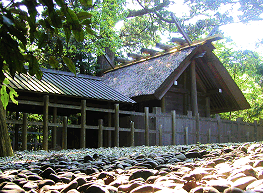 Ise Jingu is considered the most sacred Shinto shrine in Japan. The outer
shrine is sacred to the goddess of harvest. The inner shrine is are dedicated
to the sun goddess Amaterasu Omikami, who is believed to be the ancestress
of the Japanese royal family. The wooden structures are rebuilt and rededicated
every twenty years, in the exact manner of the previous building. They are
built of plain hinoki (cypress), with joints of interlocking wood pieces—no
nails are used. In each rebuilding, an important part is the training of
apprentices by the older carpenters. The rebuilding has happened every 20
years since 690. (Back when the adult life expectancy was somewhere in the
late 40’s, 20 years might have been the longest interval possible to allow
the plans and techniques to be passed on. A carpenter would probably participate
in two rebuildings, one as an apprentice about 20 years old and one as a
master of about 40 teaching new apprentices.)
Ise Jingu is considered the most sacred Shinto shrine in Japan. The outer
shrine is sacred to the goddess of harvest. The inner shrine is are dedicated
to the sun goddess Amaterasu Omikami, who is believed to be the ancestress
of the Japanese royal family. The wooden structures are rebuilt and rededicated
every twenty years, in the exact manner of the previous building. They are
built of plain hinoki (cypress), with joints of interlocking wood pieces—no
nails are used. In each rebuilding, an important part is the training of
apprentices by the older carpenters. The rebuilding has happened every 20
years since 690. (Back when the adult life expectancy was somewhere in the
late 40’s, 20 years might have been the longest interval possible to allow
the plans and techniques to be passed on. A carpenter would probably participate
in two rebuildings, one as an apprentice about 20 years old and one as a
master of about 40 teaching new apprentices.)
|
|
Kyoto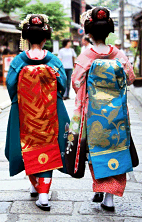 Kyoto was the capital of Japan from 794 to 1868. It is still in many ways
the center of traditional Japan, because its buildings escaped most of the
bombing of WWII. Besides having many of the most important and beautiful
old temples and shrines, Kyoto is fascinating just for the sights of the
side streets, where a visitor may glimpse a traditional geisha on her way
to an evening’s entertainment.
Kyoto was the capital of Japan from 794 to 1868. It is still in many ways
the center of traditional Japan, because its buildings escaped most of the
bombing of WWII. Besides having many of the most important and beautiful
old temples and shrines, Kyoto is fascinating just for the sights of the
side streets, where a visitor may glimpse a traditional geisha on her way
to an evening’s entertainment.
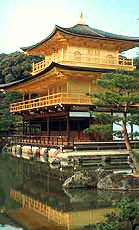 The Golden Pavilion, (Kinkakku-ji) originally built around 1400 was intended
as a place to retire by the shogun Yoshimitsu. Burnt down by a mad student
monk in 1950, it was completely rebuilt, and the upper two stories again
covered in gold leaf. The first story is built in a palace style, the second
story in a samurai style, and the third story in a Zen style, each story
becoming more intimate and less public. There is a Chinese phoenix on the
roof. The pond which mirrors the Golden Pavilion dates back to the original
building, and illustrates the Buddhist creation myth.
The Golden Pavilion, (Kinkakku-ji) originally built around 1400 was intended
as a place to retire by the shogun Yoshimitsu. Burnt down by a mad student
monk in 1950, it was completely rebuilt, and the upper two stories again
covered in gold leaf. The first story is built in a palace style, the second
story in a samurai style, and the third story in a Zen style, each story
becoming more intimate and less public. There is a Chinese phoenix on the
roof. The pond which mirrors the Golden Pavilion dates back to the original
building, and illustrates the Buddhist creation myth.
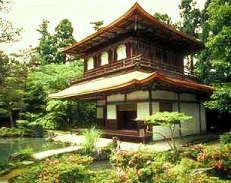 The Silver Pavilion, was built by Ashikaga Yushimasa, grandson of the builder
of the Golden Pavilion, who had inherited the position of Shogun. Originally
intended to be covered in silver leaf, as the Golden Pavilion is covered
in gold leaf, the pavilion is simply wood, perhaps more in keeping with
its position as a Buddhist temple. The tea room was personally designed
by Murata Shuko, considered to be the first tea master, and Japanese tea
rooms after this have followed from his design. There is a dry garden of
carefully raked sand, called the Sea of Silver Sand, meant to evoke the
calm sea on a moonlit night.
The Silver Pavilion, was built by Ashikaga Yushimasa, grandson of the builder
of the Golden Pavilion, who had inherited the position of Shogun. Originally
intended to be covered in silver leaf, as the Golden Pavilion is covered
in gold leaf, the pavilion is simply wood, perhaps more in keeping with
its position as a Buddhist temple. The tea room was personally designed
by Murata Shuko, considered to be the first tea master, and Japanese tea
rooms after this have followed from his design. There is a dry garden of
carefully raked sand, called the Sea of Silver Sand, meant to evoke the
calm sea on a moonlit night.
|
|
Lake Biwa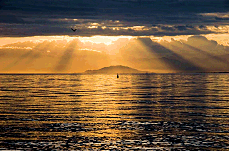 Lake Biwa is the world’s third oldest lake, and it has had time to develop
a large and diverse ecosystem. It is believed that the lake was created
at the same time as Mt Fuji, being the result of a massive earthquake that
accompanied the birth of Fuji. The name of the lake comes from the relationship
of its shape to that of a biwa, a stringed instrument.
Lake Biwa is the world’s third oldest lake, and it has had time to develop
a large and diverse ecosystem. It is believed that the lake was created
at the same time as Mt Fuji, being the result of a massive earthquake that
accompanied the birth of Fuji. The name of the lake comes from the relationship
of its shape to that of a biwa, a stringed instrument.
|
Return to Top |
Inland Sea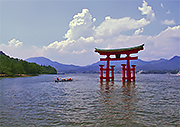 Inland Sea of Japan Surrounded by Honshu Island and Shikoku Island, the
inland sea is dotted with small picturesque islands, many of which have
old-fashioned inns, or ryokans. Beautiful at any time, it is said that spring,
when the cherry trees bloom and autumn, when the leave turn color are the
best times to take a ferry through the islands.
Inland Sea of Japan Surrounded by Honshu Island and Shikoku Island, the
inland sea is dotted with small picturesque islands, many of which have
old-fashioned inns, or ryokans. Beautiful at any time, it is said that spring,
when the cherry trees bloom and autumn, when the leave turn color are the
best times to take a ferry through the islands.
|
|
Tokaido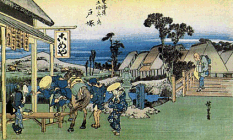 The Tokaido was the road connecting Kyoto, where the Emperor resided and
Edo (now Tokyo). It was originally meant for the use of the lords and their
servants on government business, but traffic soon increased. Religious pilgrimages
to various shrines became popular, as well as merchants moving goods, etc.
Hiroshige’s woodblock prints Fifty-three Stations of the Tokaido show the beautiful, often rugged, scenery and people of all kinds along
the road.
The Tokaido was the road connecting Kyoto, where the Emperor resided and
Edo (now Tokyo). It was originally meant for the use of the lords and their
servants on government business, but traffic soon increased. Religious pilgrimages
to various shrines became popular, as well as merchants moving goods, etc.
Hiroshige’s woodblock prints Fifty-three Stations of the Tokaido show the beautiful, often rugged, scenery and people of all kinds along
the road.
The Tokaido was almost too well located as almost all of it has been built over, from houses and shopping districts to railroads and even superhighways. A small stone-paved portion of the old road can be seen near Hakone. Efforts are being made to mark and restore more of this historic road. |
|
Kisokaido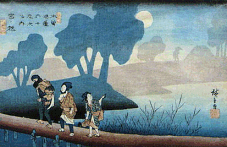 The Kisokaido road also went between Kyoto and Tokyo, but along the mountains,
not near the coast. Since it goes along mountain ridges, it has not been
built upon as much, and more of the old road remains. There was a major
government “check point” on the Kisokaido, so naturally there was a secondary
road or trail that went around this check point. Parts of the Kisokaido
have been reconstructed, and it is possible to travel parts of it on foot
today.
The Kisokaido road also went between Kyoto and Tokyo, but along the mountains,
not near the coast. Since it goes along mountain ridges, it has not been
built upon as much, and more of the old road remains. There was a major
government “check point” on the Kisokaido, so naturally there was a secondary
road or trail that went around this check point. Parts of the Kisokaido
have been reconstructed, and it is possible to travel parts of it on foot
today.
|
|
Mt. Fuji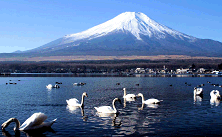 Mt. Fuji rises majestically above Japan, a symbol of beauty and transcendence
to the Japanese. Being a volcanic mountain, Fuji is an unusually
symmetrical
single cone, rising abruptly from the surrounding countryside. It is said
that Fuji is the most-climbed mountain in the world. There are ten stations
on the trail, but there are paved roads up to the fifth station, which is
where many people start their ascent. In the customary climbing months,
July and August, there are many people on the four main trails to the summit.
To the Japanese, climbing with other people with the same goal is an important
part of the experience.
Mt. Fuji rises majestically above Japan, a symbol of beauty and transcendence
to the Japanese. Being a volcanic mountain, Fuji is an unusually
symmetrical
single cone, rising abruptly from the surrounding countryside. It is said
that Fuji is the most-climbed mountain in the world. There are ten stations
on the trail, but there are paved roads up to the fifth station, which is
where many people start their ascent. In the customary climbing months,
July and August, there are many people on the four main trails to the summit.
To the Japanese, climbing with other people with the same goal is an important
part of the experience.
|
|
Sake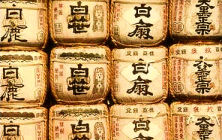 Nishinomiya is the source of the water used to make the best sake (they
say). The water from this area is known as Miyamizu, and some Japanese sake
makers from other parts of Japan import this water for their sake. Since
the finished sake is about 80% water, water plays a major role in its taste.
Miyamizu is not the most “pure” water, but has trace amounts of certain
minerals, and the absence of other minerals, notably iron, which make it
ideal for producing sake.
Nishinomiya is the source of the water used to make the best sake (they
say). The water from this area is known as Miyamizu, and some Japanese sake
makers from other parts of Japan import this water for their sake. Since
the finished sake is about 80% water, water plays a major role in its taste.
Miyamizu is not the most “pure” water, but has trace amounts of certain
minerals, and the absence of other minerals, notably iron, which make it
ideal for producing sake.
|
|
Jigokudani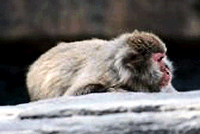 Macaques -- a kind of monkey with a short tail—are native to the mountains
in Honshu, the furthest north of any primate except man. The weather is
below freezing and snowy during the winter months in this area. The macaques
have discovered the comfort of being in the natural hot springs around Jigokudani,
lounging in them even as the snow falls on their heads. Certain hot springs
have been set aside just for the monkeys, where they can be watched.
Macaques -- a kind of monkey with a short tail—are native to the mountains
in Honshu, the furthest north of any primate except man. The weather is
below freezing and snowy during the winter months in this area. The macaques
have discovered the comfort of being in the natural hot springs around Jigokudani,
lounging in them even as the snow falls on their heads. Certain hot springs
have been set aside just for the monkeys, where they can be watched.
|
|
Tokyo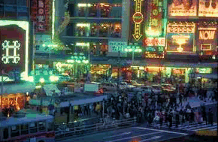 Tokyo is the extremely modern capital of Japan, a center for international commerce and innovation, and a shopping destination.
Tokyo is the extremely modern capital of Japan, a center for international commerce and innovation, and a shopping destination.
|
|
© Owl and Mouse 2007